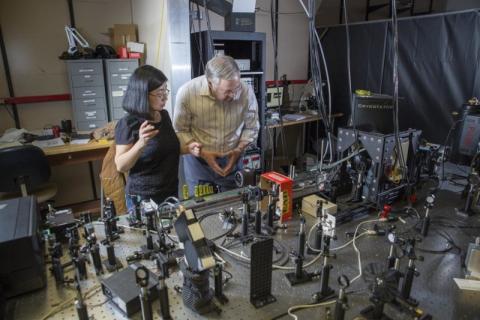|
Perovskite-Info weekly newsletter
|
|
| |
|
2017-05-24 04:11:00-04
Researchers at Lomonosov Moscow state University have designed a new method that allows to obtain highly crystalline organic-inorganic perovskite films for solar cells.
Currently, two main approaches are used for obtaining such materials. The first one involves coating with chemical agents from a vaporous state and the second one is solution crystallization. "As part of the study we've found out several new compounds - polyiodides, which are liquid at room temperature, possessing unique properties. They look like viscous liquids of dark brown color with metal gleam, obtained from two solid powders, which simply melt while blending. Liquid state of such compounds allows not to use hazard solvents and, moreover, their chemical composition contributes to formation of a necessary perovskite upon contact with a metallic lead film or other lead compounds. As a result of the chemical interaction between a lead film and polyiodide melts, a perovskite film, comprised of large interpenetrating crystals, is formed", a team member explains.
Read more... |
| |

| |
|
2017-05-24 04:29:04-04
Researchers from Lund University in Sweden and Fudan University in China have designed a new structural organization using perovskites that could greatly benefit perovskite-based solar cells. Perovskites, in their regular form, are sensitive to moisture and dissolve in contact with water, and even normal humidity deteriorates the material. Now, the researchers claim to have overcome this problem. 
"We have succeeded in producing thin sheets with a water-repelling surface, making the whole construction much more stable. In addition, we have succeeded in orienting the sheets so as to obtain acceptable solar cells, with an efficiency of ten percent," says professor of chemical physics at Lund University.
Read more... |
| |

| |
|
2017-05-25 04:02:24-04
Researchers at the National Institute of Standards and Technology (NIST) and the University of Nebraska have found evidence for a property of perovskites that may affect their long-term stability as solar cells. The unexpected feature that the team found is known as ferroelasticity, a spontaneous rearrangement of the internal structure of perovskites in which each crystal subdivides into a series of tiny regions, or domains, that have the same atomic arrangement but which are oriented in different directions. This rearrangement creates a spontaneous strain in each domain that exists even in the absence of any external stress (force).
Read more... |
| |

| |
|
2017-05-25 06:41:05-04
Researchers from the Korea Advanced Institute of Science and Technology (KAIST) and Sungkyunkwan University have developed a perovskite-based semi-transparent solar cell that is reportedly highly efficient and functions very effectively as a thermal mirror.
A major key to achieving semitransparent solar cells is to develop a transparent electrode for the cell's uppermost layer that is compatible with the photoactive material. The Korean team developed a 'top transparent electrode' (TTE) that works well with perovskite solar cells. The TTE is based on a multilayer stack consisting of a metal film sandwiched between a high refractive index layer and an interfacial buffer layer. This TTE, placed as a solar cell's top-most layer, can be prepared without damaging ingredients used in the development of perovskite solar cells. Unlike conventional transparent electrodes that only transmit visible light, the team's TTE both allows visible light to pass through and reflects infrared rays.
Read more... |
| |

| |
|
2017-05-30 02:13:28-04
EPFL researchers have designed a new type of inorganic nanocomposite that makes perovskite quantum dots (nanometer-sized semiconducting materials with unique optical properties) exceptionally stable against exposure to air, sunlight, heat, and water. 
Quantum dots made from perovskites have already been shown to hold potential for solar panels
, LEDs and laser technologies. However, perovskite quantum dots have major issues with stability when exposed to air, heat, light, and water. The EPFL team has now succeeded in building perovskite quantum dot films with a technique that helps them overcome these weaknesses.
Read more... |
| |

| |
|
2017-05-30 02:13:29-04
EPFL researchers have designed a new type of inorganic nanocomposite that makes perovskite quantum dots (nanometer-sized semiconducting materials with unique optical properties) exceptionally stable against exposure to air, sunlight, heat, and water. 
Quantum dots made from perovskites have already been shown to hold potential for solar panels
, LEDs and laser technologies. However, perovskite quantum dots have major issues with stability when exposed to air, heat, light, and water. The EPFL team has now succeeded in building perovskite quantum dot films with a technique that helps them overcome these weaknesses.
Read more... |
| |

| |
|
2017-05-30 06:10:02-04
Researchers from the University of Utah discovered that organic-inorganic hybrid perovskites feature two contradictory properties - easily controlled electron spin and long spin lifetime (up to a nanosecond). This is a unique combination of two highly sought after properties for spintronics devices. 
The specific material used in this research is the hybrid perovskite methyl-ammonium lead iodine (CH3NH3PbI3). In their study, a thin film of this material was placed in front of an ultrafast laser that was used to set the electron's spin orientation and also observe the spin precession.
Read more... |
| |
|













